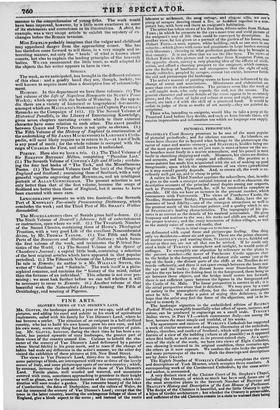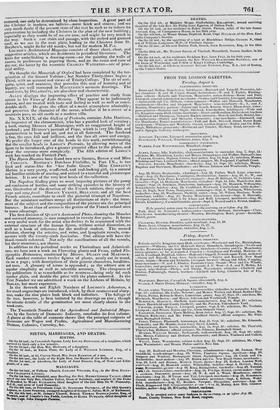PICTORIAL PERIODICALS.
STANFrEto's Coast Scenery promises to be one of the most popular of pictorial periodicals ; and for obvious reasons. As islanders, sea views have charms for us beyond what belongs to the picturesque cha. racter of coast and marine scenery ; and STANFIELD, besides being one of the most popular names in art just now, is most at home on the sea: he breathes most freely in a marine atmosphere, and his pencil is molt facile in sketching shippingand craft. Moreover, his views are distinct and accurate, and his style simple and effective. His practice as a scene-painter has made him acquainted with the art of making up good foregrounds ; upon which the attractiveness of sea views (paradoxical as it may sound) greatly depends. And, to crown all, the work is excellently well got up, and is cheap in price.
A notice in the Third Number apprizes the subscribers, that, in order
to give to the work a stronger national interest as well as character, the descriptive accounts of the principal, naval depots among our seaports, such as Portsmouth, Plymouth, 8re. will be rendered as complete as possible. Of this we have an instance in the present number, which commences with Portsmouth. The views of Porchester Castle, the Needles, Stonehouse Bridge, Plymouth, and St. Malo, have the appearance of local fidelity—one of the strongest attractions as well as the greatest merit of the landscape painter, and a quality which is one of STANFIELD'S leading characteristics. The topography of his pictures is as correct as the details of his nautical accessories. He gives buoyancy and motion to the sea ; his rocks and cliffs are solid, and of the proper texture ; and the crazy tenements of fisher-villages, as well as the stately ruins of some old castle, that " Holds its blind visage out to the lone sea."
are delineated with equal force and picturesque feeling. One thing only we desiderate—more air and space. These are the prime elements of marine scenery; and wanting them, STANFIELD'S views, faithful and clever as they are, arc not all that can be wished. If he could only steal a little of TURNER'S atmosphere and sunlight, he would unite all suffrages. To exemplify our objection by reference to the plates in the present number—the tower of Porchester Castle appears close to the bridge in the foreground, and the distant stile seems just at the top of the bank ; the distant parts of the cliffs at the Needles do not recede sufficiently, and there is not space enough between the boats near the eye and the rocks ; the distant house near Stonehouse Bridge catches the eye before the fishing-boat in the foreground, there being no air between these objects, and the bridge itself comes too forward; there is not sufficient space between the figures in the foreground and the Castle of St. Maio. The linear perspective is correct in all; it is the aerial perspective alone that is deficient. We may pass by a want of variety in the atmospheric effects, but the absence of atmosphere must be felt. We make a point of urging this deficiency, in the hope that the artist may feel the force of the objection, and so be induced to remedy it. The landscape vignettes in the embellished edition of ROftERS'S Poetical Works, exemplify beautifully what effect of space, vastness, and colour, can be produced in engravings on a small scale. TURNER'S Italian views, in Part VI.—which commences Italy—are among the best, because the most simple and truthful, of his works. The appearance and success of WINKLES'S Cathedrals has suggested a work of similar neatness and cheapness, illustrative of the cathedrals, abbeys, churches, and castles of Scotland ; which will possess the novel feature of a view of the building (where at all possible) as it appeared when first built, as well as one in its present ruined state. As a specimen of the style of the work, we have two views of Elgin Cathedral, one showing it restored to its original condition, three centuries ago, the others as it now appears. We confess the ruin looks the grander and more picturesque of the two. Both the drawings and descriptions are by JOHN GRANT. The Eighth Number of WINKLES'S Cathedrals completes the views and descriptions of York Minster, which occupies three numbers. A corresponding work of the Continental Cathedrals, by the same artists and author, is announced.
A very distinct view of the Cloister Court of St. Stephen's Chapel,,
including the Oratory, of which so much has been said, forms one ot the most attractive plates in the Seventh Number of BRITTON and BRAYLEY'S History and Description of the Late Houses of Parliament. The design of the Cloisters is beautiful, and the little Oratory is quite a bijou of Gothic architecture ; but whether the Oratory is preservabl. e, and sufficient of the old Cloisters remain in a state to warrant their being restored, can only be determined by close inspection. A great part of the Cloister is modern, we believe—mere brick and stucco ; and we very much doubt if the present state of the rest be such as to induce its preservation by including the Cloisters in the plan of the new building ; especially as they would be of no use now, and might be very much in the way. Such n row stairs and passage, with the arched and groined roof, as we see in the next plate, leading to the Cloisters from St. Stephen's, might do for old monks, but not for modern M. P.s. LOUDON'S Architectural Magazine consists of those short, clear, and suggestive articles, which are desiderata in periodical literature. The hints for embellishing a drawing-room—on the painting the walls of rooms, in preference to papering them, and on the cause and cure of dry-rot, the latter by the eccentric CHARLES WATERTON—are of practical utility.
We thought the Memorials of Oxford had been completed by the termination of the Second Volume ; but Number Thirty-three begins a Third, with an account and views of Trinity College. The air of antiquity. quiet, and neatness, that pervades this seat of learning and of bigotry, are well conveyed in MACKENZIE'S accurate drawings. 'fire wood-cuts, by DELAMOTTE, are also clear and characteristic.
ALLOM displays the improving effect of practice and study from nature in his Views of Lake Scenery. They appear to be judiciously chosen, and are treated with taste and feeling As well as well as considerable skill. He gives the effect of a moist atmosphere admirably; and preserves the character of the scene, whether it be a street or a mountain pass, an old castle or a modern villa. No. XX XIX. of the Gallery of Portraits, contains John Harrison, the improver of the chronometer, who has a puzzled look of scrutiny ; a hard, staring likeness of Montaigne, with an exaggerated height of forehead ; and HUDSON'S portrait of Pope, which is very life-like and characteristic in look and air, and not at all flattered. The forehead
is fine, the eyes full and brilliant, and the face all sense arid energy.
We prefer the larger size of the heads in this work, notwithstanding that the smaller heads in LODGE'S Portraits, by allowing more of the figure to be introduced, give a greater pictorial effect to the plates, arid show the costume more completely. The fifth edition of LODGE'S work has reached its Fortieth Part.
The Byron Beauties have found two new limners, Boss o 2K and Miss F. CORBAUX. BOSTOCK'S Dutchess Fitzfulke, in Part IX., is too fixed and statue-like for "her frolic Grace." Miss CORBAUX'S
Marion is a very pretty, unaffected, and real-looking girl, in a natural and familiar attitude of musing, and attired in a tasteful and picturesque fashion. It is one of the very best beads of the collection.
The Napoleon Gallery gives us most imposing pictures of the pomp and confusion of battles, and some striking episodes in the history of war, illustrative of the devotion of the French soldiers, their esprit de corps and sangfroid. HORACE VERNET, BELLANGE, and all the best French artists, contribute to swell the pictorial triumph of Napoleon. But the miniature outlines merge all distinctions of style : the treatment of the subject and the composition of the picture are the principal features. In no class of scenes is the genius of the French school seen to more advantage. The first division of Q L'AIN'S Anatomical Plates, showing the Muscles and outward anatomy, is now completed in twenty-five parts. It forms a very useful work for the artist who desires to be acquainted with the external structure of the human figure, without actual dissection, as well as a book of reference for the medical student. The second division, showing the arteries, and veins, and lymphatic vessels, commences with the twenty-sixth faseiculus. One edition will have the blood-vessels coloured. Not only the ramifications of all the vessels, but their structures, are shown.
In addition to the periodical works on Floriculture and Arboriculture, we have now a work on Flowering plants arid Ferns called Florigraphia Britannica, conducted by Messrs. DEAKIN and MmiNocit. Each number contains twelve figures of plants, neatly cut in wood, six on a page ; with descriptions of their generic characters, localities, and uses.A glossary of terms is appended ; as the editors aim at popular simplicity as well as scientific accuracy. The cheapness of this publication is as remarkable as its neatness—being only fid. each number plain, and double the price with the plates coloured. In the First Number we see advertised a work on the Lichens of Britain, by Dolma, but more expensive.
In the Seventh and Eighth Numbers of LOUDON'S Arboretum, a few wood-engravings are introduced, which, by their neatness and sharp ness, make the zinc plates look black and indistinct. The foliage of the tree, however, is best imitated by the drawings on zinc; though the minute details of the germination are most clearly shown in the wood-cuts.
The Twentieth Number of the Agricultural and Industrial Magazine, by the Society of Domestic Industry, concludes its first volume. A glance at the table of contents shows that the principal subjects of discussion are Wages and Profits, Agricultural and Manufacturing Distress, Colonies, Currency, &c.



























 Previous page
Previous page